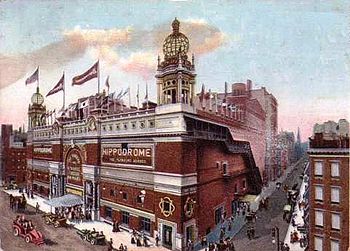| New York Hippodrome | |
|---|---|
 The Hippodrome in 1907, on a hand-tinted postcard | |
 | |
| General information | |
| Status | Demolished |
| Classification | Theater |
| Town or city | Manhattan, New York City |
| Country | United States |
| Coordinates | 40°45′21″N 73°59′00″W / 40.7558°N 73.9833°W |
| Completed | 1905 |
| Demolished | 1939 |
| Design and construction | |
| Architect(s) | Frederic Thompson and Jay Herbert Morgan |
| Main contractor | contractor: Frederick Thompson and Elmer Dundy construction firm: George A. Fuller Company |
| Other information | |
| Seating capacity | 5,300 |
The Hippodrome Theatre,[1][2][3][4][5] also called the New York Hippodrome, was a theater located on Sixth Avenue between West 43rd and West 44th Streets in the Theater District of Midtown Manhattan in New York City. The theater operated from 1905 to 1939 and was called the world's largest theater by its builders, with a seating capacity of 5,300[6] and a stage measuring 100 by 200 feet (30 m × 61 m).[7] It had state-of-the-art theatrical technology, including a tank built into the stage apron that could be filled with water for aquatic performances.[8]
The Hippodrome was built by Frederic Thompson and Elmer "Skip" Dundy, creators of the Luna Park amusement park on Coney Island, with the backing of Harry S. Black's U.S. Realty, a dominant real estate and construction company of the time,[9] and was acquired by The Shubert Organization in 1909. It became the stage for Billy Rose's Jumbo in 1935. Acts which appeared at the Hippodrome included numerous circuses, musical revues, Harry Houdini's disappearing elephant, vaudeville, religious meetings, political rallies, and sporting events.[7]
The theater closed in August 1939,[7] and a modern office tower known as The Hippodrome Center (1120 Avenue of the Americas) opened on the site in 1952.
- ^ "Raze Old Hippodrome Theater in New York; Will Build 'Taxpayer'". Chicago Tribune. July 9, 1939. Archived from the original on April 11, 2013. Retrieved February 22, 2013.
- ^ George C. Izenour (1996). Theater Technology. ISBN 0300067666. Retrieved February 22, 2013.
- ^ David Ewen (1970). New complete book of the American musical theater. Holt, Rinehart, and Winston. ISBN 9780030850608. Retrieved February 22, 2013.
Hippodrome Theater.
- ^ Armond Fields (January 22, 2002). Fred Stone: Circus Performer and Musical Comedy Star. ISBN 9780786411610. Retrieved February 22, 2013.
- ^ Sheldon Patinkin (May 20, 2008). "No Legs, No Jokes, No Chance": A History of the American Musical Theater. ISBN 9780810119949. Retrieved February 22, 2013.
- ^ Shanor, Rebecca Read. "Hippodrome" in Jackson, Kenneth T., ed. (2010). The Encyclopedia of New York City (2nd ed.). New Haven: Yale University Press. pp. 597–598. ISBN 978-0-300-11465-2.
- ^ a b c Gray, Christopher (May 22, 2005). "From a Palace of Spectacles to an Edifice of Offices". The New York Times. ISSN 0362-4331. Retrieved July 15, 2024.
- ^ Stalter-Pace, Sunny (January 2023). "Disappearing Mermaids: Staging White Women's Mobility through Aquatic Performance at the New York Hippodrome". Theatre Survey. 64 (1): 3–23. doi:10.1017/S0040557422000527.
- ^ Alexiou, Alice Sparberg (2010). The Flatiron: The New York Landmark and the Incomparable City that Arose With It. New York: Thomas Dunne/St. Martin's. pp. 188–193. ISBN 978-0-312-38468-5.